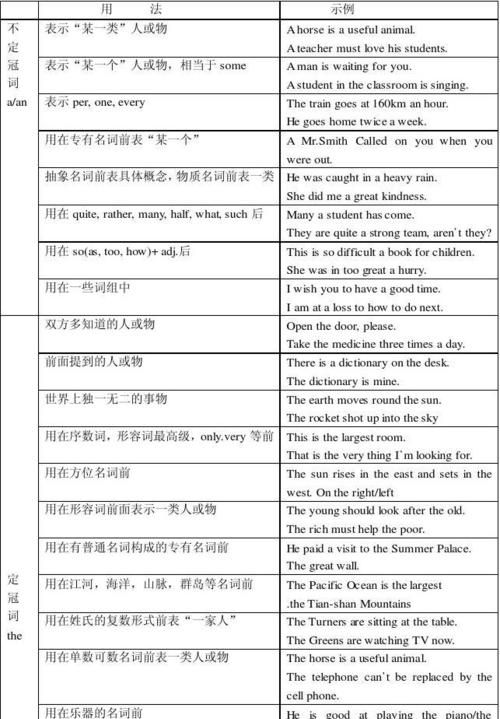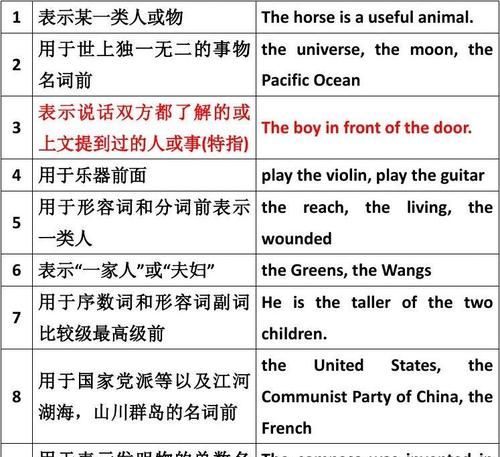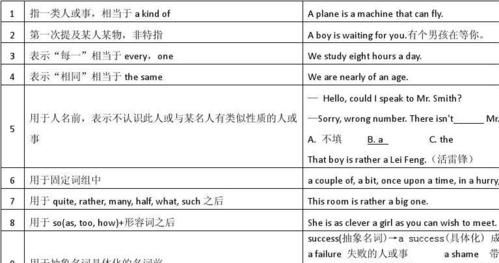本文目录
英语定冠词的用法总结
1 表示特指的人或物
例:Please hand me the key on the desk. 请把桌上的钥匙递给我。
The girl in red is his sister. 穿红色衣服的女孩是他妹妹。
The building over there is the tallest in the town. 那边那幢大楼是这个城里最高的。
I like the music of the film. 我喜欢这部电影的音乐。
2 表示双方都知道的或心中明白的人或物
例: Shut the door, please. 请关门。
Has he returned the book? 那本书他还了吗?
Take the blue one, it is cheaper. 拿那个蓝的,它便宜些。
3 第二次提到
某人或某物第一次提到时用不定冠词,第二次提到时要用定冠词。
例:He saw a house in the distance. Jim's parents lived in the house. 他看见远处有一所房子,吉姆的父母就住在那所房子里。
There was once an old fisherman. The old fisherman had a cat. The cat was white. 从前有一个老渔夫。这个老渔夫有一只猫。这只猫是只白猫。
4 用在世界上独一无二的名词前
这类词有: the sun太阳, the earth地球, the moon月亮,
the sky天空, the world 世界
例:The moon goes round the earth. 月亮绕着地球转。
There is not any cloud in the sky. 天空中没有一丝云彩。
It was a fine day in spring. The sun shone brightly. 这是一个晴朗的春日,阳光灿烂。
He is the richest man in the world. 他是世界上最富的人。
5 用在表示方向、方位的名词前
这类词有: the east东方,the west西方,the south南方,
the north北方,the right右边,the left左边
例:The birds are flying to the north. 这些鸟向北方飞去。
The moon rises in the east and sets in the west. 月亮从东方升起,在西方落下。
The wind was blowing from the south. 风从南方吹来。
She lived to the west of the Summer Palace. 她住在颐和园的西边。
Walk along the road and take the first turning on the right. 沿着这条路往前走,在第一个路口往右拐。
He stood at the back of the door. 他站在门背后。
提示
方位词成对使用构成平行结构时,不用定冠词。
例:The river is two thousand kilometers long from west to east. 这条河自西向2000公里长。
They traveled through the country from south to north. 他们自南向北在这个国家旅行。
6 用在形容词最高级前
例:Summer is the hottest season of the year. 夏天是一年中最炎热的季节。
She is the best person for the job. 她是最适合这个工作的人。
Hangzhou is one of the most beautiful cities in the world. 杭州是世界上最美的城市之一。
The car is the most expensive of the four. 这部车是四部车中最贵的。
7 用在序数词等前
定冠词用在序数词前,也用在表示序列的next, last等前,还有在表示“同一”或“唯一”等的词前。
例:The first man to land on the moon is an American. 第一个登上月球的人是美国人。
She was the fifth to climb to the top of the mountain. 她是第五个到达山顶的人。
This may be the last chance. 这可能是最后一次机会。
If I miss this train I'll catch the next one. 如果赶不上这趟火车,我就赶下一趟。
He is the only person who knows the secret. 他是唯一一个知道这个秘密的人。
The two coats are of the same colour. 这两件外衣颜色相同。
This is the very book I want. 这正是我要的书。(用very表示强调)
提示
a 序数词表示“又一”时,前面用不定冠词a(an)
例:He bought a second pair of shoes. 他又买了一双鞋。
He asked a question, then a second, then a third…他问了一个问题,又问了第二个,第三个……
b 序数词用作状语或表语时,前面不加定冠词。
例:George arrived first. 乔治第一个到。
=George was the first person to arrive.
Jim and Jack are both second in the match. 汤姆和杰克在比赛中并列第二。
8 用在单数名词前表示一类人或物,强调整个类别
例:The orange is a kind of fruit. 橘子是一种水果。
The horse is a useful animal. 马是一种有用的动物。
The computer is important to us. 电脑对我们来说是重要的。
提示
不定冠词+单数名词,不带冠词的复数名词也可表示一类人或物。
例:A car runs faster than a bus. 小汽车比公交车跑得快。
Cars run faster than buses.
A dog is a faithful animal. 狗是忠实的动物。
Dogs are faithful animals.
9 用在乐器名词前,表示演奏
例:She can play the piano. 她会弹钢琴。
He plays the violin very well. 他小提琴拉得很好。
He played the guitar for the children. 他给孩子们弹了吉他。
提示
但乐器名词表示具体的器物,或表示课程时,不加the.
例:He bought a piano last month. 他上个月买了一架钢琴。
She taught piano in the school. 她在学校里教钢琴。
10 用在江河、海洋、湖泊、群岛、山脉的名称前例:
the Yangtze River 长江
the Red Sea 红海
the West Lake 西湖
the Pacific 太平洋the Himalayas 喜马拉雅山
the Nile 尼罗河
the Rocky Mountains 落基山脉
the South China Sea 南中国海
提示
例外的情况: Mount Tai 泰山China Daily 《中国日报
11 用在由普通名词和另外一些词构成的专有名词前例:
the Great Wall 长城
the United Nations 联合国
the New York Times 《纽约时报》
the United States of America 美国
the Red Cross Hospital 红十字医院the Olympic Games 奥林匹克运动会
the Shanghai Railway Station 上海火车站
the People's Republic of China 中华人民共和国
the North Pole 北极
the People's Daily 《人民日报》
12 用在某些形容词前,表示一类人或物或某种抽象概念
例: the old 老年人
the happy 幸福的人
the poor 穷人
the aged 老人
the sick 病人
the impossible 不可能的事the young 年轻人
the rich 富人
the blind 盲人
the wounded 伤员
the smooth 顺事
the beautiful 美,美的东西
The rich should help the poor. 富人应该帮助穷人。
The good is what people like. 人们总是喜欢美好的东西。
The wounded have been sent to the hospital. 伤员已经被送到医院去了。
13 用在姓氏的复数形式前,表示全家人或这一姓的夫妇二人
例:The Greens will more to the country. 格林一家要搬到乡下去。
The Wangs came to see us yesterday. 王家一家人昨天来看我们。
The Browns are very friendly. 布朗夫妇都很友好。
14 用在表示计算单位的名词前,含有“每,每一”的意思
例:Jim is paid by the hour. 吉姆的工资按小时付。
Eggs are sold by the kilogram. 鸡蛋按千克出售。
This cloth is sold by the yard. 这种布按码出售。
It sells at three dollars the pound. 它以每磅三美元出售。
They sell sugar by the pound. 他们按磅卖糖。
15 用在前面已提到过的人的身体部位或衣着的名词前
这种用法是先把整个对象说出来,然后再说到那个对象的身体的局部或衣着。
结构: 动词(hit, pull, pat, strike, catch, hold, take)
+sb. +介词(in, on, by, across)+身体部位或衣着
例:She touched him on the shoulder. 她碰了碰他的肩。
He took the girl by the hand. 他拉着小女孩的手。
He hit her on the nose. 他打了她的鼻子。
The stone struck the man in the eye. 石头击中了那人的眼睛。
I caught her by the right hand. 我抓住她的右手。
比:她拍了拍那男孩的头。
She patted the boy on his head. (误,本结构中身体部位或衣着前不用one's)
She patted the boy on the head. (正)
16 用在逢十的复数数词前,表示年代,也指人的大约岁数
例:The war broke out in the forties. 那场战争发生在40年代。
He went abroad in the 1980s. 他在20世纪80年代出国的。
The old man is in the seventies. 老人大约七十几岁。
17 用在表示自然现象的名词前
这类名词有: the rain 雨,the wind风, the fog雾,the snow雪,
the air空气, the storm风暴,the snowstorm 暴风雪
例:Don't stand in the rain. 不要站在雨中。
The wind blew down the trees. 风把树刮倒了。
The ship sank in the storm. 船在风暴中沉没了。
The rain has cleaned the air. 下雨净洁了空气。
The fog was so thick that we couldn't see the top of the hill. 雾很大,我们看不见山顶。
提示
a 这类名词前有形容词修饰时,可用不定冠词,表示“一场,一阵,一种”
例:A cold wind is blowing from the north. 冷风从北方吹来。
There was a heavy rain last night. 昨晚下了一场大雨。
A heavy snow is falling outside. 外面正下着大雪。
b 这类名词表示一般物质时,不用冠词。
例:Rain falls in summer; snow falls in winter. 夏天下雨,冬天下雪。
Man can't live without air. 没有空气人不能活。
18 用在某些习惯用语中
例:
in the morning 在上午
in the evening 在晚上
in the field 在田野里
in the country 在乡间
in the sun 在阳光下
in the distance 在远处
on the right 在右边
by the way 顺便说一下
in the front of 在前部
in the daytime 白天
go to the concert 去听音乐会
at (/in) the beginning 开始
at the moment 当时,此刻
all the year round 一年到头
go to the cinema 去看电影
go to the theatre 去看戏
at the weekend 周末in the afternoon 在下午
in the night 在夜里
in the sky 在空中
in the dark 在暗处
in the rain 在雨中
in the shade 在阴凉处
on the left 在左边
all the time 始终
in the middle of 在中间
on the way home 回家途中
all the same 依然
on the whole 总之
at the same time 同时
on the plane 在飞机上
in the year 2008 在2008年
the other day 前几天
at the bottom of 在……底部
in the end 终于
on the one hand, on the other hand 一方面,另一方面
提示
下面几个短语前不加定冠词:
例:at dawn 在黎明
at night 在晚上
at noon 在正午
at dusk 在黄昏

英语中冠词和不定冠词的用法
不定冠词有"a和an"两种形式。"a"用在以辅音开头的词前,"an"用在以元音开头的词前。判断一个词是以元音开头还是以辅音开头,是根据读音而不是根据字母。一般情况下,开头字母是a、e、i、o、u前用不定冠词an。当字母单独出现时 A E I O R S F H L X 也要使用不定冠词"an",其次特别要注意的是 U 这个字母单独出现发的并不是原音 同理 UNIVERSITY USUAL也都不用不定冠词"an"。
1. 用于可数名词的单数形式前,表示"一"
There is a tiger in the zoo.
动物园里有一只老虎。
2. 表示一类人和东西
A tiger can be dangerous.
老虎可能有危害性。
3. 表示"某一个"的意思
A gentleman wants to see you.
有一位先生要见你。
4. 表示"同一"的意思
They are nearly of an age.
他们几乎同岁。
The two shirts are much of a size.
这两件衬衫大小差不多。
5. 表示"每一"的意思
We go swimming four times a week.
我们每周去游泳四次。
6. 用在作表语的单数可数名词前,表示身份、职业
My mother is a teacher.
我妈妈是教师。
7. 第一次提到的人或事物,但不特别指明是哪一个
Long long ago there was an old king who had a very beautiful daughter.
很久很久以前,有一个年老的国王,他有一个非常美丽的女儿。
8. 在英国英语中,以"h"开头的多音节词,如第一个音节不重读,其前亦可用"an"
There is an hotel near here.
这附近有一家旅馆。
9. 在such a,quite a句式中
He is quite a good actor.
他是一个相当好的演员。
Don't be in such a hurry.
不要如此匆忙。
10. 在感叹句 what...的句式中
What a pretty girl she is!
她是一个多么漂亮的女孩呀!
用在某些表示数量的词组中:
a lot of 许多
a couple of 一对
a great many 很多
a dozen 一打(但也可以用 one dozen)
a great deal of 大量
[编辑本段]定冠词的用法
1. 用以特指某(些)人或某(些)事物
This is the house where Luxun once lived.
这是鲁迅曾经住过的房子。
2. 用于指谈话双方都明确所指的人或事物
Open the door, please.
请把门打开。
3. 用以复述上文提过的人或事物(第一次提到用“a或an”,以后再次提到用“the”)
Once there lived a lion in the forest. Every day the lion asked small animals to
look for food for him.
从前森林里住着一只狮子。每天这只狮子要小动物们为他寻找食物。
4. 用在序数词和形容词最高级前
January is the first month of the year.
一月份是一年当中的第一个月。
Shanghai is the biggest city in China.
上海是中国最大的城市。
5. 表示宇宙中世界上独一无二的事物
the sun 太阳 the moon 月亮
the earth 地球 the sky 天空
the world 世界
6. 指由普通名词构成的专有名词
the West Lake 西湖 the Great Wall 长城
the United States 美国 the United Nations 联合国
定冠词的用法-2
7. 表示方向、方位 用在表示计量的名词前{度量衡} by the ton/pound/yard/metre/kilo 注意by后面接上表示面积 体积 重量 长 高 短 深时 中间不加冠词 如by volume/weight/length/width/depth
in the east 在东方 in the west 在西方
in the front 在前面 at the back 在后面
in the bottom 在底部 at the top 在顶部
on the right 在右边 on the left 在左边
8. 在海洋、江河、湖泊、山脉、海峡、海湾等地理名词前
the Pacific Ocean 太平洋 the Huanghe River 黄河
the Tianshan Mountains 天山山脉 the Taiwan Straits 台湾海峡
9. 在姓氏复数前,表示一家人
The Bakers came to see me yesterday.
贝克一家人昨天来看我。
10. 和某些形容词连用,使形容词名词化,代表一类人或物
the poor 穷人 the rich 富人
the sick 病人 the wounded 伤员
the good 好人 the beautiful 美丽的事物
11. 用在表示阶级、政党的名词前
the working class 工人阶级
the Chinese Communist Party 中国共产党
12. 用在the very强调句中
This is the very book I want.
这就是我想要的那本书。
13. 在the more, the more比较级的句式中
The more you drink, the more you like it.
你越喝就越爱喝。
14. 表示演奏乐器时,乐器的前面要加the
play the piano 弹钢琴
play the violin 拉小提琴
*中国乐器名词前不与冠词连用:play erhu(二胡)]
the+n{发明物} 必须是单数
who invented the telephone?
15. 某些固定的表达法
in the morning 在早上 in the afternoon 在下午
in the evening 在晚上 go to the cinema 去看电影
go to the theatre 去看戏 all the year round 一年到头
on the way to 前往...去的路上
16. the加单数可数名词可以表示一类人或事物
The horse is a useful animal.
马是一种有用的动物。
注意:像这类句子还有如下两种写法
A horse is a useful animal.
Horses are useful animals.
17.在句型“动词+sb.+介词+the+身体某一部位”中要用 the,而不
用人称代词。
take sb. by the arm 抓住某人的手臂
hit sb. in the face 打某人的脸
be red in the face 脸红
be lame in the right leg 右腿瘸 等结构中,名词前要用the
18 用在世纪或逢时{1990}的复数名词前
in the18th century 在18世纪
in the 1960s 在1960年
19 多与民族 国籍的形容词连用
the chinese are brave hard-working people 中国人是勤劳和勇敢的人
20 用于报刊 杂志 会议 条义 历史 时期 朝代的名词前
the Xian incident 西安事变
[编辑本段]零冠词的用法
1. 专有名词前一般不加冠词
China 中国 Europe 欧洲
Lei Feng 雷锋 William Shakespeare 威廉•莎士比亚
2. 月份、星期、节日前一般不加冠词
January 一月份 Sunday 星期日
Christmas Day 圣诞节 Thanksgiving 感恩节
National Day 国庆节 May Day 劳动节
比较: ...on a Sunday morning.
在一个星期天的早晨... (表示某一个。)
注:民族节日前要加the 如:the Spring Festival
3. 三餐、四季前一般不加冠词
I have lunch at school.
我在学校吃午餐。
Summer is the best season for swimming.
夏天是游泳的好季节。
比较: I had a big lunch yesterday.
昨天我吃了一顿丰盛的午餐。(表示某一个)
The dinner given by Mr Smith was very nice.
史密斯先生款待的晚宴真是美味。(表示特指)
比较: I will never forget the summer we spent in Hawaii.
我永远不会忘记我们一起在夏威夷度过的那个夏天。
(表示特指)
4. 进行球类运动
play basketball 打篮球 play volleyball 打排球
play football 踢足球
5. 没有特指的物质名词
This cart is made of wood.
这辆手推车是用木头作的。
比较: The wood outside was all wet.
外面的那些木头都湿了。(表示特指)
6. 没有特指的不可数抽象名词
Time is precious.
时间是宝贵的。
比较: The time of the play was 1990s.
这个剧本的时代背景是二十世纪九十年代。(表示特指)
7. 没有特指的可数名词复数形式后。
I like tomatoes.
我喜欢西红柿。
8. 山峰
Mount Qomolangma 珠穆朗玛峰
9. 固定词组
go to school 去上学 go to bed 上床睡觉
go by train 乘火车去 go by boat 乘船去
at table 在用餐 in hospital 住院
at school 求学 in school 求学
at noon 在中午 at night 在晚上
at midnight 在半夜 in town 在城里
10. 独立结构中的名词不加冠词
A boy came in, book in hand.
一个男孩进来,手上拿着书。
11. 泛指人类
Man is mortal.
人必有一死。
12. 在"kind of+名词 sort of+名词"句式中
What kind of flower is it?
这是什么花?
I like this sort of book.
我喜欢这种书。
13. 指职位、头衔的词,如king,captain,president,chairman 等。
He is (the) captain of the team.
他是球队的队长。
As (the) chairman of the committee, I declare the meeting open.
作为委员会主席,我宣布会议开始。
冠词和三餐的搭配
三餐名词单独使用时,之前通常不加冠词
三餐名词之前若加形容词时则除外:
We have breakfast at eight.
我们8点钟吃早饭。
He gave us a good breakfast.
他请我们吃了一顿丰盛的早餐。
I was invited to dinner.
他们邀请我吃饭。
I was invited to a dinner given to welcome the new ambassador.
我被邀请参加欢迎新任大使的宴会。
The Scots have porridge for breakfast.
苏格兰人早餐吃粥。
The wedding breakfast was held in her father’s house.
婚礼早宴是在她父亲家举行的。
[编辑本段]介词短语与冠词
一.、当下列名词指其“主要目的”,即与其相关在行为时,要用零冠词。
at table 在进餐
at the table 在桌子旁边
at desk 在读书
at the desk 在课桌旁
at school 在上学
at the school 在学校里
in class 在上课
in the class 在班级里面
in bed 卧床
in the bed 在床上
in prison 坐牢
in the prison (因事)在监狱
in hospital 住院
in the hospital (因事)在医院
go to school 去上学
go to the school (因事)去学校
go to bed 上床睡觉
go to the bed 在床上
go to hospital 去看病
go to the hospital 去医院
二.
take place 发生
take the place 代替
in place of 代替
in the place of 在...的地方
in case of 万一
in the case of 就...来说
out of question 毫无疑问
out of the question 完全不可能
通常使用不定冠词的短语
after a while 过了一会儿
all of a sudden 突然
as a rule 通常
as a result 结果,因此
as a matter of fact 事实上
as a whole 大体上
at a loss 不知所措
in a hurry 急忙
in a way 在某种程度上
in a word 总而言之
It’s a pity that… 令人遗憾的是…
put an end to… 结束…
come to an end 结束
come to a conclusion 得出结论
have a good time 玩得愉快
have a rest 休息一下
have a cold 感冒
have a word with 和…谈一谈
keep an eye for 对…有鉴赏力
make a living 谋生
make a fire 生火
make a fool of 愚弄
take a walk 散步

冠词是什么
冠词(Article)是一种虚词,在句子中一般不重读,本身不能独立使用,只能与名词放在一起(一般用于名词之前 )帮助说明名词所指的人或事物,包含不定冠词(Indefinite Article)、定冠词(Definite Article)、否定冠词(Negative article)、部分冠词(Partitive article)和零冠词(Zero Article,即不用冠词)。
在英语中它是词性中最小的一类,简称“art.”,只有三个:不定冠词、 定冠词和零冠词。汉语中没有冠词。
冠词有两种:不定冠词(a/an)和定冠词(the)。此外有些特定场合不用冠词,即通常所谓的“零冠词”。
不定冠词
用法
不定冠词A/AN
an + a、e、i、o、f、h、l、m、n、r、s、x(12个字母单独出现读音是以元音开头的,其余字母则是以辅音开头的)
eg:There is an "a" and "n" in the word "and"
2. 特殊单词:(不发元音的情况)
a uniform a university
a useful book a European
a one-way street 一条街
an hour an honest boy (拼读时h不发音,o发元音)
a/an+序数词 又一个
eg:I have a third apple . 我又吃了一个苹果.(表示一共吃三个)
3. ① 用在可数名词的单数形式前,表示一类事物或人中的任意一个
eg:Be sure to bring me a dictionary. 一定要给我带本字典来。
② 用在可数名词的单数形式前,表示一类事物或人,
eg:An ear is an organ for listening. 耳朵是听觉器官。
③用在专有名词前,表示"一个"“一种”“一类”或“一个类似......的”
定冠词“the”
1.the + 名词 + 介词短语.
eg:Show me the photo of your family. 给我看看你家人的照片。
↑定语
注:不是所有被定语修饰的名词都要加定冠词。如果该定语不能够或者不用于明确该名词的所指对象,则不加定冠词。如:Show me a photo of your family. 给我一张你家人的照片。(言外之意:这样的照片可能有很多。)
His attention was attracted by a picture on the wall. 墙上的一张画引起了他的注意。(墙上也许只有一张画,也许有很多,但两种情况都可以用不定冠词,因为从说话的语气上看,这里的后置定语只是起到描述作用,而不是用来区分。)
2.用在重新提到的人或事物前面
eg:I met a lovely girl at the gate.Look,this is the girl who is coming.
我在门口遇到一个可爱的女孩,看.就是正走来的这个女孩。
3.用在谈话双方都知道的人或事物面前
eg:Please fill in the form and sign it. 请填写表格并签字。
4.用在单数可数名词前,表示某一类人或事物
eg:The tiger is a wild animal. 老虎是一种野生动物。
5.用在世界上独一无二的事物或方位名词前面
eg:the east 东方 the universe 宇宙
6.用在序数词形容词最高级及only所修饰的词前面
eg:It‘s the second country they will visit in Asia. 这是他们在亚洲第二个参观的国家。
Autumn is the best season in Beijing. 秋天是北京最好的季节。
He is the only student who didn’t pass the exam . 他是唯一一个没有通过考试的学生。
7.用在江河、湖海、山脉、岛屿等
eg:the River Seine塞纳河
8.用在普通名词构成的专有名词前.
eg:the Great Wall长城
9.用在姓氏的复数形式前.
eg:the Greens 格林一家
10.用在乐器名词前
eg:play the piano 弹钢琴
11.和某些形容词连用,表示一类人或事物.是复数概念
eg:the rich富人
注意:在有些词组中,有冠词和无冠词意思不同,请注意区别:
in front of
in the front of
in hospital
in the hospital
哪些地方不用
专有名词、物质名词、抽象名词的名词前不用冠词
eg: China 中国 May五月 Tom 汤姆
2.表示一类人或事物的复数名词前不用冠词
eg:We are all students. 我们都是学生。
3.有物主代词、指示代词、不定代词或名词所有格修饰的名词前不用冠词
(√) Mike's school is over there. 麦克的学校就在那边。
(×) The Mike‘s school is over there.
4.表示特别含义的名词前不用冠词
eg: He usually has his supper at home. 通常他都在家里吃晚饭。
5.家庭成员的名称、称呼或只有一个人担任的职务名词前不用冠词
eg:Sir,please show me another one. 先生,请给我看另一个。
6.与by连用的交通工具前不用冠词
eg:by car乘汽车 by taxi 乘出租车
7.两个相同或相对的名词构成的平行结构前不用冠词
eg:day and night 日夜
8.在有些词组中,有无冠词含义不同
eg:school,bed...等为表示“处所”的名词,不是指具体地点,不用冠词
当指明地点.或是为了目的去这些处所时,它们前面就要加上冠词
含有冠词
含有a的词组
have a word with sb. 和某人谈话
have a drink 喝点什么
many a time 许多次
have a good time 过得愉快
have a swim游泳
have a bath/shower 洗澡,淋浴
have a look (at) 看一看
have a fever 发烧
give a lesson 授课
in a/one word 总之(一句话)
have a talk谈话
have/take a walk 散步
have a nice trip 有一个愉快的旅途
have a rest 休息一下
含有the词组
in the daytime在白天
at/in the beginning 开始
in the middle night 在半夜
in the end 最后,终于
by the way 顺便说一下
the same as... 同..一样
in/at the front of...在某物的前部
on the right/left 在右边/左边
in the morning/afternoon/evening 在上午/下午/晚上
总结
The dog is a useful animal.
A dog is a useful animal.
Dogs are useful animals.介词短语
一.、当下列名词指其“主要目的”,即与其相关在行为时,要用零冠词。
at (/) table 在进餐
at the table 在桌子旁边
at (/) desk 在读书
at the desk 在课桌旁
at (/) school 在上学
at the school 在学校里
in (/) class 在上课
in the class 在班级里面
in (/) bed 卧床
in the bed 在床上
in (/) prison 坐牢
in the prison (因事)在监狱
in (/) hospital 住院
in the hospital (因事)在医院
go to (/) school 去上学
go to the school (因事)去学校
go to (/) bed 上床睡觉
go to the bed (因事)在床上
go to (/) hospital 去看病
go to the hospital (因事)去医院
二.
take (/) place 发生
take the place 代替
in (/) place of 代替
inthe place of 在...的地方
in (/) case of 万一
in the case of 就...来说
out of (/) question 毫无疑问(100%)
out of the question 完全不可能 (0%)
通常使用不定冠词的短语
after a while 过了一会儿
all of a sudden 突然
as a rule 通常
as a result 结果,因此
as a matter of fact 事实上
as a whole 大体上
at a loss 不知所措
in a hurry 急忙
in a way 在某种程度上
in a word 总而言之
It’s a pity that… 令人遗憾的是…
put an end to… 结束…
come to an end 结束
come to a conclusion 得出结论
have a good time 玩得愉快
have a rest 休息一下
have a cold 感冒
have a word with 和…谈一谈
keep an eye for 对…有鉴赏力
make a living 谋生
make a fire 生火
make a fool of 愚弄
take a walk 散步

冠词的用法总结
冠词是一种虚词,用在名词或名词词组的前面,表示名词是特指还是泛指。冠词可分为不定冠词和定冠词两种形式。 不定冠词有 a, an。 定冠词有 the. 其中, a 用在发音以辅音开头的名词之前, 而 an 则用在发音以元音开头的名词之前。
不定冠词的用法:
1) 表示某一类人或某事物中的任何一个,经常用在第一次提到某人或某物时,用不定冠词起介绍作用,表示一个。
I gave him a book yesterday.
我昨天给了他一本书。
I am reading an interesting story .
我在读一本有趣的故事书。
I have got a ticket.
我有一张票。
There is a tree in front of my house.
我的屋前有一棵树。
2) 表示人或事物的某一种类, 强调整体, 即以其中的一个代表一类。
A horse is useful to mankind.
马对人类有用。
A bird can fly.
鸟会飞。
A steel worker makes steel.
炼钢工人炼钢。
3) 不定冠词用在事物的"单位"前,如时间, 速度, 价格等意义的名词之前,表示 "每一"。
We often go to school two times a day.
我们常常一天两次去学校。
I went to the library once a week at least.
我一星期至少去一次图书馆。
The potato is sold at about 30 fen a jin.
土豆卖三毛钱一斤。
4) 不定冠词用来指某人某物,但不具体说明任何人或任何物。
A boy came to see you a moment ago.
刚才有一个小孩来找你。
I got this tool in a shop.
我在商店买的这件工具。
We need a car now.
我们现在需要一辆车。
She is ill, she has to see a doctor.
她病了,她得去看病。
5) 不定冠词用于某些词组。
a few 几个 a little 有点
She has a few friends in this city.
她在这个城市中有几个朋友。
There is a little milk in the bottle.
瓶子里有点牛奶。
Only a few students are in the classroom.
只有几个学生在教室里。
定冠词的用法。
1) 定冠词特指某(些)人或某(些)事物, 以区别于同类中其他的人或事物。
The bag in the desk is mine.
桌子里的书包是我的。
Is this the book you are looking for?

以上就是关于冠词总结归纳 ,英语定冠词的用法总结的全部内容,以及冠词总结归纳 的相关内容,希望能够帮到您。

